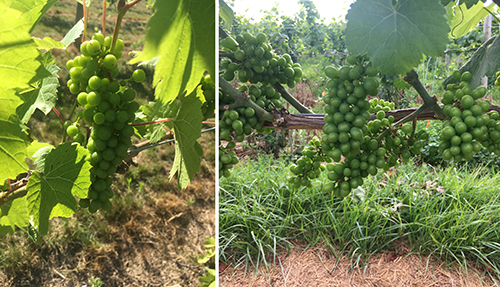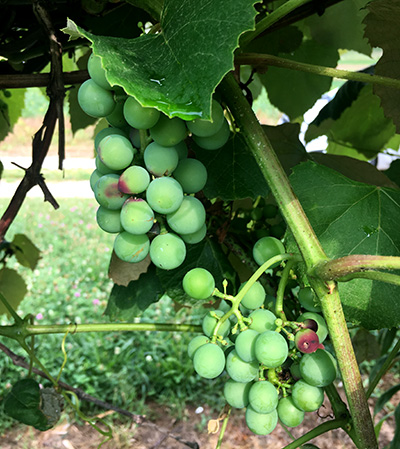Southwest Michigan grape scouting report for July 11, 2017
Grapes continue to size. Attend to canopy management for disease control. Second-generation berry moth egglaying continues.

Development
Fruit are continuing to size rapidly. In Concord and Niagara, primary clusters are in the berry touch stage. Secondary clusters are a bit behind (see image), as expected.
|
Growing degree-day (GDD) accumulations |
||||
|---|---|---|---|---|
|
Enviroweather Station |
Date of wild grape bloom |
GDD47 since wild grape bloom |
Start of egglaying (810GDD47) |
Start of egg hatch (910 GDD47) |
|
May 26 |
1006 |
July 2 |
July 6 |
|
|
May 27 |
994 |
July 3 |
July 7 |
|
|
May 27 |
996 |
July 3 |
July 7 |
|

Current state of development of Pinot Noir grape clusters near Berrien Springs (left) and Marquette grape clusters near Benton Harbor (right).
Disease
Appearance of most disease symptoms has remained light thus far in the season. That may change with recent and upcoming rains. The fruit of Concord, Niagara and earlier-blooming wine grape varieties are now resistant to new infections of powdery mildew, downy mildew and black rot.
Later-blooming varieties, including the vinifera, are still vulnerable to cluster infections of powdery mildew (another week or so), black rot (two more weeks) and downy mildew (rachises become resistant in a week or so). Therefore, protection from these diseases should continue until they are resistant.
Once the fruit are fully resistant to new infections, careful scouting and responsive cover for leaf infections of downy and powdery mildew begins. Good protectants for downy mildew include Copper products, Ziram, Captan (not permitted by National Grape) and EBDCs (not permitted by National Grape after bloom). Materials with some systemic activity on downy mildew include Revus and associated products, the Phosphonates, and Ridomil (only one spray a year for resistance management).
SI materials, SDHIs and sulfur products are good protectants for powdery mildew, with some back-action. The oils, salts, biological materials and oxidant products all provide excellent eradicant and anti-sporulant activity. Oils and biologicals (especially Double Nickel, Sonata and Serenade) are also decent protectants.
See the Michigan State University Extension bulletin E0154, “2017 Michigan Fruit Management Guide,” for more information.
Now that the canopies are filled in, shoot positioning and leaf removal techniques can reduce the pressure from downy mildew and powdery mildew infections on leaves, black rot infections on fruit while they are still vulnerable (another week or so in wine grapes), and other fruit infections later in the season.
It is in our interest to create an environment where it is more difficult for the fungal disease to survive, meanwhile increasing spray coverage to the fruit by removing obstacles. Any canopy management increasing air and light penetration is called for at this time.
For more information on controlling current diseases found in grapes, read "Keep an eye on foliar and fruit diseases in grapes" from MSU Extension.
Insects
Scout now for grape leafhoppers, potato leafhoppers and Japanese beetles. Japanese beetles are most common adjacent to pasture and turf. Treat with a neonicotinoid if either species of leafhopper gets out of hand; spot-treat with a contact poison for Japanese beetle where needed.
Spotted wing Drosophila (SWD) were caught in vineyards where harvest-time pests have been a problem in the past. Hang a couple of traps for SWD and prepare to treat pre-harvest (carefully following pre-harvest intervals) if caught.
Grape berry moth second-generation flight and egglaying continues, and Enviroweather’s grape berry moth model predicts egg hatch is beginning now in area vineyards. The first feeding stings are now visible, mostly in areas adjacent to woodlands.

Grape berry moth feeding sting on Concord clusters.
Insecticides should have been be applied last week to achieve the best control, especially ingestion poisons (Altacor, Intrepid, Delegate, Entrust and BT products). In fields that did not receive an application, apply a contact poison now to get some control of second-generation berry moth larvae (Danitol, Hero, Baythroid, Imidan, Sevin and their generics are the best on grape berry moth).
As always, thanks for reading! Don’t be afraid to contact us at baughm30@msu.edu or masonk@msu.edu for questions, comments or suggestions.



 Print
Print Email
Email




